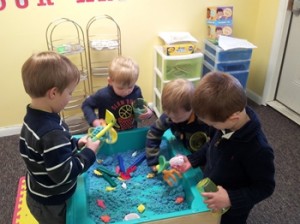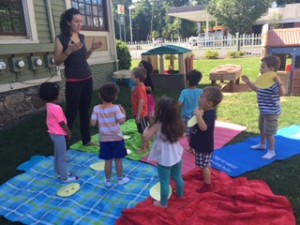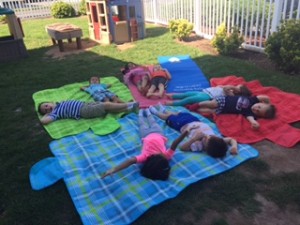Preschool Program

The Preschool Curriculum is designed in a way that respects individual differences and that all children will experience joy and delight as they grow and develop socially and academically in a nurturing home-like environment. The classroom is set up and designed for children to come to learn and explore in a safe, loving, caring, and monitored atmosphere.
Children learn best in an active environment where they can design, choose, implement and influence their activities. Teachers create and implement daily lesson plans on a theme-based calendar and use practices from Creative Curriculum and the New Jersey Core standards. Children are taught as a group and individually based on each child’s needs and development. Learning Centers have been instrumental in helping children practice skills.
The ideal classroom is based on areas that are designed to help young children grow and develop. The learning centers in the classroom are as followed:
Circle Time – Children begin their day through meaningful experiences like storytelling, songs, finger plays, and an explanation of what the focus of the day is. Children learn to express their ideas and associate the written word with the spoken word. Circle time is a whole group activity.
Art – Creative Art may be an independent or a group activity where children are developing small muscle control, hand-eye coordination, and self-esteem. They are expressing themselves through various forms of media like paint, crayons, markers, glue, textured materials, and scissors just to name a few.
Language/Library – Children are developing their reading, pronunciation, and spelling skills. They are cultivating their understanding of patterning and sequencing and practicing their fine motor skills necessary for reading and writing through tactile letters, pictures, tracing shapes and letters, and beads. Children are beginning to expand their experiences of the world through books and discussions. They are learning that pictures have meanings and that pictures and words can tell a story. Children are also exercising their language and listening skills and finding enjoyment in the written word.
Blocks – Children are developing an understanding of the relationship between size and shape, learning to think and plan, and being introduced to the basic math concepts of geometry and numbers. Children build and create with blocks of various sizes, colors, and shapes.

Dramatic Play – Children are learning to share and work together as they explore both the familiar and unknown through pretend play. They are practicing verbal skills and developing an understanding of symbolic representation that leads to the development of reading and writing skills. This area is filled with real and fake props and dress-up clothes to encourage children’s imagination.
Science – Children are stimulated by exploring cause and effect through fun-filled experiments and by asking questions, expanding their communication and cognitive thinking. Children may find interesting objects from nature, leaves, rocks, seashells, and science bottles in the science area to explore. Other materials in which children can explore are plants, magnifying glasses, water-table, and magnets.
Sensory – The water and the sand table are equipped with cups, funnels, and sieves to encourage children to explore and understand the physical world, and to develop concepts underlying math and science, and physics. Children will explore and experiment through the sense of touch and feel.
Computer and Technology – Children will learn to work together as they become familiar with computer usage and computer parts. They will be introduced to educational computer software through interactive games learning phonics, counting and numbers, shapes and patterns, and finding letters on the keyboard. They will use programs like starfall.com. Computer usage is always monitored by the teacher.

Manipulatives – Children develop fine motor skills by using their fingers and hands in creative ways. They are developing eye-hand coordination and practicing problem-solving skills. Children have the opportunity to work on puzzles, pegboards, geometric boards, and building complex structures. They also carefully string beads into colorful patterns.
Gross Motor – Children are encouraged to utilize the large muscles of the body like in their arms, legs, and core. Children are engaged in activities that have them move around and exercise. They get to dance, jump, skip, hop, crawl and roll around. They get to use their full body for music and movement, use scarves to wave around, and push and ride scooters. They are encouraged to do this outside and inside the classroom.
Music and Movement – Children will learn the use of patterns and rhythm through songs and dance. They will develop a sense of body space and awareness, body movement, balance, and coordination. Listening to words as they are sung in a pattern can facilitate language learning and encourage the development of auditory discrimination.
Lilypads School House Preschool Schedule
7:00-9:00 Breakfast – Free Play – Table Activities
9:00-9:30 Music and Movement
9:30-10:00 A.M. Snack Time
10:00- 10:30 Circle Time
10:30-11:15 Arts and Crafts/ Sensory Play
11:15-12:00 Lunch
12:00-2:00 Quiet Time/Nap Time
2:00-2:30 P.M. Snack Time
2:30-3:00 Math/Language Small Group
3:00-3:45 Gross Motor Play/or Outdoor play
3:45-4:30 Center Time/Extra Curriculum Activities
4:30-5:00 Goodbye Circle
Our daily activities include:
- Age –appropriate educational materials that support learning and development through play by using manipulatives, hands-on tools, and educational resources
- Children are developing skills in language and math based on each child’s needs and growth
- Theme-based activities are provided daily
- Children choose a job each week to learn the importance of responsibility and being a team player. It also gives them a sense of pride and ownership. The jobs are called “Helping Hands”.
- The low teacher-child ratio which provides more interaction with the teacher and one on one engagement
- Computer usage to help with math and language development
- Detailed report sent home daily about child’s day
- Lesson plans are posted each week for parents to view
- Exploring each center in the classroom to enhance play
- Learning to socialize and engage with others
- Use our sense of expression through art as an individual or as a group
- Language Small group- children work on letter recognition and identification, letter sounds, formation, matching upper and lower case letters, reciting songs and fingerplays, recognizing his/her name, sequences 3 pictures to tell a story, listening, and following 2 to 3 step directions, engage in reading books aloud by listening and answering related questions, use pictures and drawings to communicate ideas
- Math Small group- children work on counting up to 20, identifying and recognizing numbers, counting objects with meaning, sorting by color, shape, and size, demonstrating concepts of positioning/directional, identifying colors, recognizing and duplicating patterns, seriates objects based on one attribute
- Gross Motor Play – Children steer scooters and use their legs to ride, jump in place, and land on two feet, practicing balancing, hopping on one foot, practice throwing a large, medium, and small ball in one direction, walking up and down the stairs, jumps consecutively-6 jumps,
- Children are provided with lunch and snacks from home
- Children have a two-hour rest period
Extra Curriculum Activities:
Spanish – Learning the basics in Spanish like colors, shapes, numbers, days of the week, months, food, songs, and phrases.
Yoga – Learning basic yoga poses like butterfly, downward dog, mountain, star, shooting star, lion to help develop the core of the body through relaxation, balance, and strength. This will be taught through songs and books.
Computer -Children will get to develop and use the use of technology to learn language and math skills through educational computer programs like starfall.com. Children will learn to share and take turns as they get to interact using different computer programs.
Science – Children will engage in different science experiments and activities throughout the school year to enhance their curiosity and scientific minds as they partake in some hands-on experiments. As the weather permits, they will also get to plant and garden outside to observe how nature evolves.


